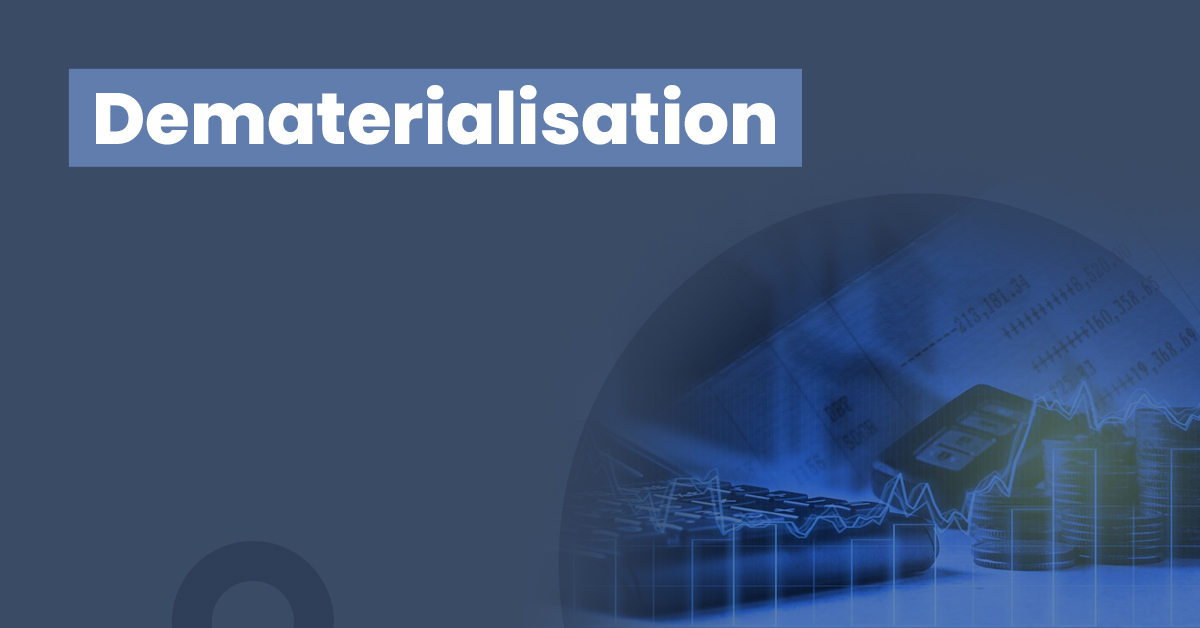Dematerialisation: Definition, Details & Benefits


With technological advancements, the need for holding physical certificates of shares and securities has diminished. Increasing digital literacy and the easy availability of digital mediums and platforms have led to the revolution of dematerialisation in India’s securities markets. Let’s learn more about it here.
What is Dematerialisation?
The process by which physical paper documents of your securities are replaced by digital certificates available online in your Demat account is called dematerialisation. The Securities and Exchange Board of India (SEBI) has made it mandatory to eliminate paper documents and has embraced dematerialisation.
There are two depositories to register your Demat accounts with. These are National Securities Depository Ltd (NSDL) and Central Depository Services India Ltd (CDSL).
How does Dematerialisation work?
In stock market parlance, the process of dematerialisation starts with opening of a Demat account. This involves a few steps mentioned below.
For first-time online stock market investors
- Shortlisting DP: DP or Depository Participants generally are brokerage firms. They have to be registered under NSDL or CDSL. An investor shall select a DP, and they will guide the investor regarding the entire process.
- Fill out the form: An investor shall fill out the Demat account opening form. You must fill in all Know Your Customer (KYC) details in that form.
- Submission of documents: The investor is required to submit the documents and certificates required to support the details provided by them.
- Verification of documents: The documents submitted by investors are reviewed and verified.
- Account activated: Once the document verification process is over, investors get their Demat account number and ID.
For investors holding shares in the physical form
After opening the Demat account following the steps mentioned above, they need to follow the instructions given below:
- Filling the DRF: For investors who have already transacted in the share market and are holding transaction balances in the accounts, they need to fill out the ‘Dematerialisation Request Form’. Investors also need to submit their share certificates with ‘Surrendered for Dematerialisation’ mentioned on each of them.
- DP takes over: DP is responsible for processing the dematerialisation request and reviewing share certificates. These are submitted to the company, registrar and transfer agents. Once the request is approved, the DP destroys all physical documents, and the depository awaits the confirmation of dematerialisation
- After confirmation: Once the request is confirmed, the previous holdings of shares will reflect in the Demat account.
The entire process might take upto thirty working days to complete.
What are the benefits of Dematerialisation?
The manifold benefits of dematerialisation are:
- Reduced paperwork: By eliminating paperwork, the risk of forgery and physical damage to certificates also gets eliminated. It also makes the entire process less tedious and more user-friendly.
- Maximum liquidity: Since buying and selling shares are just a click away, it increases the transaction rate, and thus the liquidity of the entire market is optimised.
- Saves time: Due to reduced paperwork, operating through a Demat account becomes hassle-free, and shares can be bought and sold according to an investor’s convenience. The transactions are immediate, and it can access the Demat account anytime and anywhere.
- Availing loan: Investors can obtain loans against the securities kept in the Demat account.
What are the drawbacks of Dematerialisation?
Although Demat accounts promote frictionless securities transactions, there are a few downsides to consider.
- High volatility
With high liquidity comes higher volatility. Since the entire process of buying and selling shares is instantaneous with Demat accounts, investors often look for short-term gains rather than investing for a longer period which in turn increases market volatility.
- Low digital literacy
Dematerialisation is only convenient for people with proper internet and digital device access. In India, due to the unequal distribution of wealth, everyone needs help to afford smartphones or laptops. Free internet is also not available across the country. These factors limit the benefits of dematerialisation to a few privileged investors who can afford both internet connection and digital gadgets.
Final Word
Dematerialisation offers the ease of buying and selling securities with maximum security, making it the go-to option while dealing in shares. Moreover, the entire process is transparent, digital and regulated by SEBI. Thus, investors can need not worry about unforeseen discrepancies when dealing with their Demat account transactions.
Frequently Asked Questions (FAQs)
Can I close my Demat account and transfer all securities to a different account with another DP?
Yes, on submission of a request to close the current account to the DP, they will transfer all the present holdings to the new account after closing the present one.
Can I convert my electronically held Demat shares back into physical form?
Yes, you can convert your Demat account holdings into physical form by submitting a RRF (Rematerialisation Request Form) to the respective DP.
Can I open a joint Demat account?
Yes, you can open a joint Demat account with another account holder, similar to a joint bank account. But it cannot be on an ‘either or survivor’ basis like a joint bank account.
Can odd lot shares be dematerialised?
Yes, you can also dematerialise the certificates of odd lot shares by sending a request to your respective DP.




